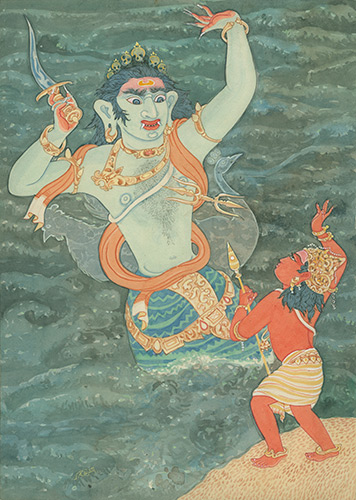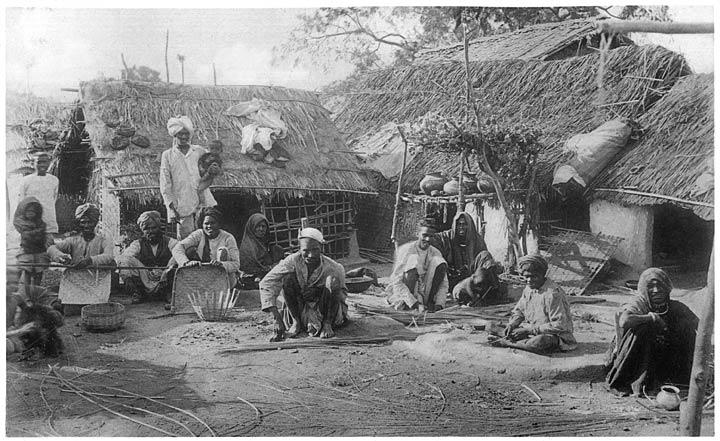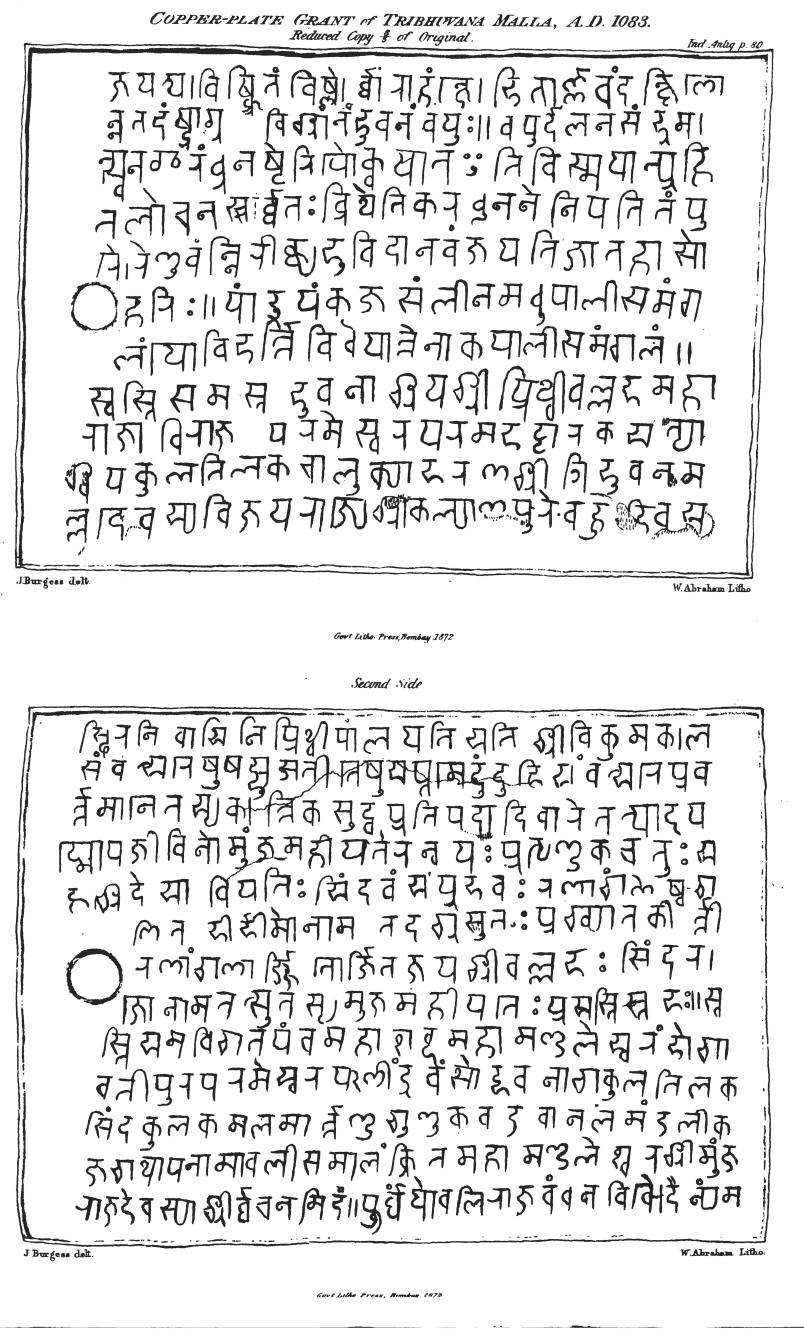|
Pratisargaparvan
The 'Bhavishya Purana' (') is one of the eighteen major works in the Purana genre of Hinduism, written in Sanskrit. The title ''Bhavishya'' means "future" and implies it is a work that contains prophecies regarding the future. The ''Bhavishya Purana'' exists in many inconsistent versions, wherein the content as well as their subdivisions vary, and five major versions are known. Some manuscripts have four ''Parvam'' (parts), some two, others don't have any parts. The text as it exists today is a composite of material ranging from medieval era to the modern era. Those sections of the surviving manuscripts that are dated to be older, are partly borrowed from other Indian texts such as ''Brihat Samhita'' and ''Shamba Purana''. The veracity and authenticity of much of the ''Bhavishya Purana'' has been questioned by modern scholars and historians, and the text is considered an example of "constant revisions and living nature" of Puranic genre of Hindu literature. The first 16 chapte ... [...More Info...] [...Related Items...] OR: [Wikipedia] [Google] [Baidu] |
Uthiramerur
Uthiramerur is a panchayat town in Kancheepuram district in the Indian state of Tamil Nadu. It is situated 90 km south west of Chennai, the capital of Tamil Nadu. It is noted for its temple inscriptions that describe a self-governance system existing around 7th to 9th century CE. History Uthiramerur originally existed as a Brahmin settlement. The Pallava king Nandivarman II (720–796 CE) formally established it as a brahamdeya village around 750 CE. It is believed that he donated the village to Vedic Brahmins from Srivaishanva community. A tenth century inscription states the name of the village as "Uttaramerur Chaturvedi Mangalam". Around 25 inscriptions, spanning reigns of around four Pallava kings, have been found at Uthiramerur. In the later part of the 9th century, the Cholas captured the region. There are inscriptions from the period of Parantaka Chola I (907–950), Rajaraja Chola I (985–1014), Rajendra Chola I (1012–1044) and Kulothunga Chola I (1070–112 ... [...More Info...] [...Related Items...] OR: [Wikipedia] [Google] [Baidu] |
Terminus A Quo
A ''terminus post quem'' ('limit after which', sometimes abbreviated TPQ) and ''terminus ante quem'' ('limit before which', abbreviated TAQ) specify the known limits of dating for events or items.. A ''terminus post quem'' is the earliest date the event may have happened or the item was in existence, and a ''terminus ante quem'' is the latest. An event may well have both a ''terminus post quem'' and a ''terminus ante quem'', in which case the limits of the possible range of dates are known at both ends, but many events have just one or the other. Similarly, a ''terminus ad quem'' 'limit to which' is the latest possible date of a non-punctual event (period, era, etc.), whereas a ''terminus a quo'' 'limit from which' is the earliest. The concepts are similar to those of upper and lower bounds in mathematics. These terms are often used in archaeological and historical studies, such as dating layers in excavated sites, coins, historical events, authors, inscriptions or texts where ... [...More Info...] [...Related Items...] OR: [Wikipedia] [Google] [Baidu] |
Alf Hiltebeitel
Alfred John Hiltebeitel (April 10, 1942 - March 12, 2023) was Columbian Professor of Religion, History, and Human Sciences at George Washington University in Washington, D.C., US. His academic specialism was in ancient Sanskrit epics such as the '' Mahabharata'' and ''Ramayana'', together with Indian religious tradition and folklore. Background Hiltebeitel was awarded a B.A. degree from Haverford College, where he majored in religion and minored in English (1959-1963). He attended the University of Chicago Divinity School, where he obtained an M.A. (1966) and a Ph.D. (1973) in the history of religions. His doctoral thesis is entitled ''Gods, Heroes, and Krsna: A Study of the Mahabharata in relation to Indian and Indo-European Symbolisms''. Hiltebeitel was an editorial assistant for Seabury Press in New York City during 1963–1964, and between 1967-1968 he held a similar post with the '' History of Religions Journal''. He was appointed an assistant professor in religion at Geo ... [...More Info...] [...Related Items...] OR: [Wikipedia] [Google] [Baidu] |
Scythia
Scythia (, ) or Scythica (, ) was a geographic region defined in the ancient Graeco-Roman world that encompassed the Pontic steppe. It was inhabited by Scythians, an ancient Eastern Iranian equestrian nomadic people. Etymology The names and are themselves Latinisations of the Ancient Greek names () and (), which were themselves derived from the ancient Greek names for the Scythians, () and (), derived from the Scythian endonym . Geography Scythia proper The territory of the Scythian kingdom of the Pontic steppe extended from the Don river in the east to the Danube river in the west, and covered the territory of the treeless steppe immediately north of the Black Sea's coastline, which was inhabited by nomadic pastoralists, as well as the fertile black-earth forest-steppe area to the north of the treeless steppe, which was inhabited by an agricultural population. The northern border of this Scythian kingdom were the deciduous woodlands, while several rivers, incl ... [...More Info...] [...Related Items...] OR: [Wikipedia] [Google] [Baidu] |
Nāga
In various Asian religious traditions, the Nāgas () are a divine, or semi-divine, race of half-human, half-serpent beings that reside in the netherworld (Patala), and can occasionally take human or part-human form, or are so depicted in art. Furthermore, nāgas are also known as Dragon, dragons and Water spirit, water spirits. A female nāga is called a Nagin, or a Naiṇī Devī, Nagini. According to legend, they are the children of the sage Kashyapa and Kadru. Rituals devoted to these supernatural beings have been taking place throughout South Asia for at least 2,000 years. They are principally depicted in three forms: as entirely human with snakes on the heads and necks, as common serpents, or as half-human, half-snake beings in Hinduism and Buddhism. ''Nagaraja'' is the title given to the king of the nāgas. Narratives of these beings hold cultural significance in the mythological traditions of many South Asian and Southeast Asian cultures, and within Hinduism and Buddhism ... [...More Info...] [...Related Items...] OR: [Wikipedia] [Google] [Baidu] |
Murugan
Kartikeya (/ kɑɾt̪ɪkejə/; ), also known as Skanda ( /skən̪d̪ə/), Subrahmanya (/ sʊbɾəɦməɲjə/, /ɕʊ-/), Shanmukha ( /ɕɑnmʊkʰə/) and Murugan (/ mʊɾʊgən/), is the Hindu god of war. He is generally described as the son of the deities Shiva and Parvati and the brother of Ganesha. Kartikeya has been an important deity in the Indian subcontinent since ancient times. Mentions of Skanda in the Sanskrit literature data back to fifth century BCE and the mythology relating to Kartikeya became widespread in North India around the second century BCE. Archaeological evidence from the first century CE and earlier shows an association of his iconography with Agni, the Hindu god of fire, indicating that Kartikeya was a significant deity in early Hinduism. He is hailed as the "favoured god of the Tamils", and the tutelary deity of the Kurinji region in Sangam literature, whose cult gained popularity later. As per theologists, the Tamil deity of Murugan coalesced ... [...More Info...] [...Related Items...] OR: [Wikipedia] [Google] [Baidu] |
Ganesha
Ganesha or Ganesh (, , ), also known as Ganapati, Vinayaka and Pillaiyar, is one of the best-known and most worshipped Deva (Hinduism), deities in the Hindu deities, Hindu pantheon and is the Supreme God in the Ganapatya sect. His depictions are found throughout India. Hindu denominations worship him regardless of affiliations. Devotion to Ganesha is widely diffused and extends Ganesha in world religions, to Jains and Buddhists and beyond India. Although Ganesha has many attributes, he is readily identified by his Asiatic Elephant, elephant head and four arms. He is widely revered, more specifically, as the remover of obstacles and bringer of good luck; the patron of The arts, arts and Science, sciences; and the Deva (Hinduism), deva of intellect and wisdom. As the god of beginnings, he is honoured at the start of rites and ceremonies. Ganesha is also invoked during writing sessions as a patron of letters and learning., Vigna means obstacles Nasha means destroy. These ideas ar ... [...More Info...] [...Related Items...] OR: [Wikipedia] [Google] [Baidu] |
Vajrasuchi Upanishad
The ''Vajrasuchi Upanishad'' (, IAST: Vajrasūcī Upaniṣad) is an important Sanskrit text and an Upanishad of Hinduism. It is classified as one of the 22 Samanya (general) Upanishads, and identified as a Vedanta text. It is attached to the Samaveda. The text discusses the four varnas also called 'caste'. It is notable for being a systematic philosophical work against the division of human beings, and for asserting that any human being can achieve the highest spiritual state of existence. History The date as well as the author of ''Vajrasūchi Upanishad'' is unclear. The Upanishad is attributed to Sankaracharya in the manuscripts discovered by early 1800s.Theodor Aufrecht (1892), , University of Bonn, Germany, page 2 see entry 8 Sankaracharya, also known as Adi Shankara, was an Advaita Vedanta scholar, but given the Indian tradition of dedicating and attributing texts to revered historical scholars, there is uncertainty whether texts attributed to Adi Shankara were actually c ... [...More Info...] [...Related Items...] OR: [Wikipedia] [Google] [Baidu] |
Caste
A caste is a Essentialism, fixed social group into which an individual is born within a particular system of social stratification: a caste system. Within such a system, individuals are expected to marry exclusively within the same caste (endogamy), follow lifestyles often linked to a particular occupation, hold a ritual status observed within a hierarchy, and interact with others based on cultural notions of social exclusion, exclusion, with certain castes considered as either more pure or more polluted than others. The term "caste" is also applied to morphological groupings in eusocial insects such as ants, bees, and termites#caste, termites. The paradigmatic ethnographic example of caste is the division of India's Hinduism, Hindu society into rigid social groups. Its roots lie in South Asia's ancient history and it still exists; however, the economic significance of the caste system in India seems to be declining as a result of urbanisation and affirmative action programs. ... [...More Info...] [...Related Items...] OR: [Wikipedia] [Google] [Baidu] |
Brahma
Brahma (, ) is a Hindu god, referred to as "the Creator" within the Trimurti, the triple deity, trinity of Para Brahman, supreme divinity that includes Vishnu and Shiva.Jan Gonda (1969)The Hindu Trinity, Anthropos, Bd 63/64, H 1/2, pp. 212–226.Jan Gonda (1969)The Hindu Trinity, Anthropos, Bd 63/64, H 1/2, pp. 218–219. He is associated with creation, knowledge, and the ''Vedas''. Brahma is prominently mentioned in Creation myth, creation legends. In some ''Puranas'', he created himself in a golden embryo known as the Hiranyagarbha. Brahma is frequently identified with the Rigvedic deities, Vedic god Prajapati.;David Leeming (2005), The Oxford Companion to World Mythology, Oxford University Press, , page 54, Quote: "Especially in the Vedanta Hindu Philosophy, Brahman is the Absolute. In the Upanishads, Brahman becomes the eternal first cause, present everywhere and nowhere, always and never. Brahman can be incarnated in Brahma, in Vishnu, in Shiva. To put it another way, eve ... [...More Info...] [...Related Items...] OR: [Wikipedia] [Google] [Baidu] |
Dharmaśāstra
''Dharmaśāstra'' () are Sanskrit Puranic Smriti texts on law and conduct, and refer to treatises (shastras, śāstras) on Dharma. Like Dharmasūtra which are based upon Vedas, these texts are also elaborate law commentaries based on vedas, Dharmashastra themselves evolved from dharmshutra. There are many Dharmashastras, variously estimated to number from 18 to over 100. Each of these texts exists in many different versions, and each is rooted in Dharmasutra texts dated to the 1st millennium BCE that emerged from Kalpa (Vedanga) studies in the Vedic era. The textual corpus of Dharmaśāstra were composed in poetic verse, and are part of the Hindu Smritis, constituting divergent commentaries and treatises on ethics particularly duties, and responsibilities to oneself and family as well as those required as a member of society. The texts include discussion of Ashrama (stage), ashrama (stages of life), varna (Hinduism), varna (social classes), Puruṣārtha, purushartha (proper g ... [...More Info...] [...Related Items...] OR: [Wikipedia] [Google] [Baidu] |






